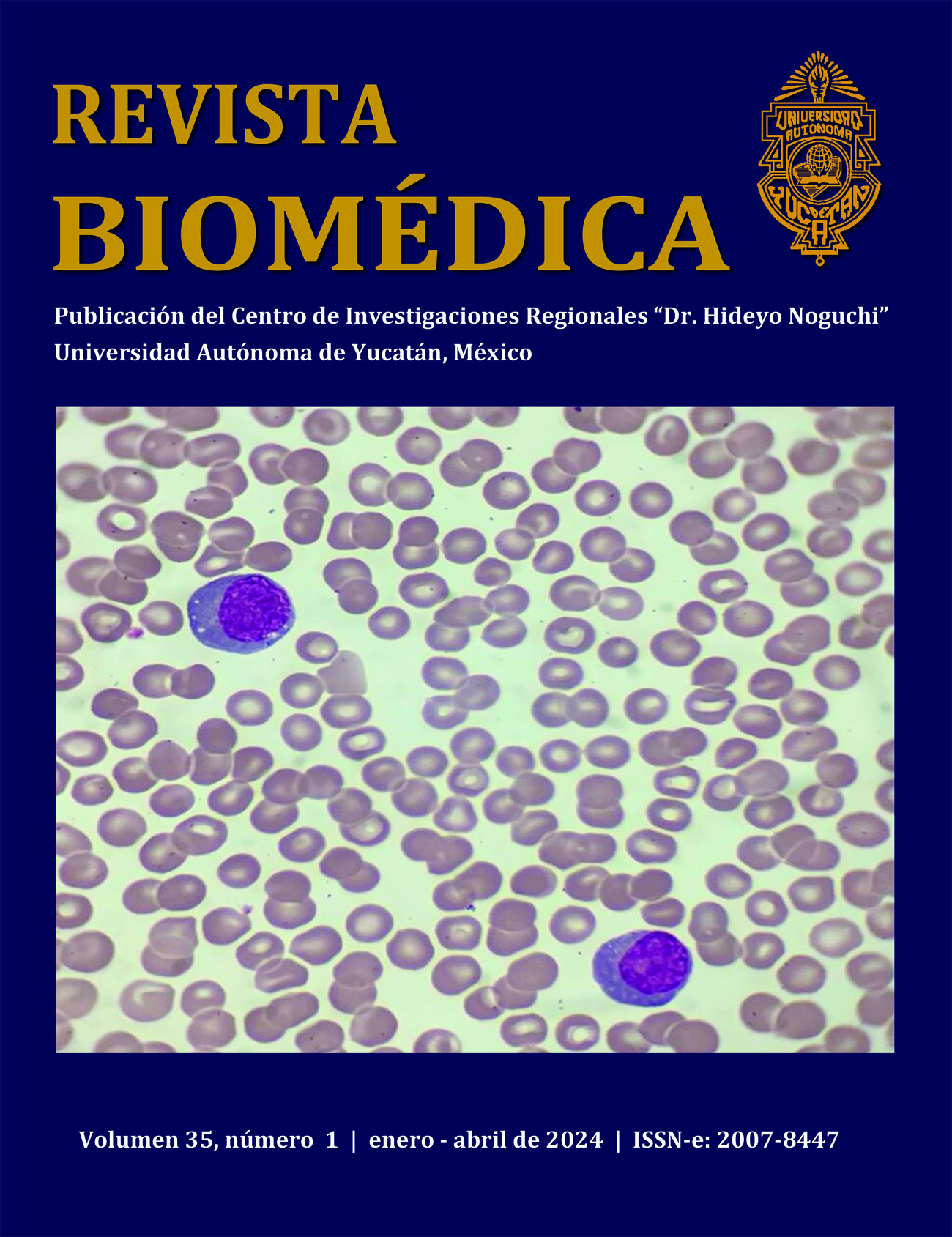Resistencia a la insulina y su relación con alteraciones antropométricas y bioquímicas en adolescentes con prediabetes
Resumen
Referencias
Instituto Nacional de Salud Pública. Encuesta Nacional de Salud y Nutrición (ENSANUT). 2016; [en línea] 2016 octubre. [Fecha de acceso 12 de abril de 2019] Disponible en: URL: https://www.gob.mx/cms/uploads/attachment/file/209093/ENSANUT.pdf.
Tuso P. Prediabetes and Lifestyle Modification: Time to Prevent a Preventable Disease. Perm J. 2014 Jul; 18(3): 88–93. DOI: 10.7812/TPP/14-002.
Tabák AG, Herder C, Rathmann W, Brunner EJ, Kivimäki M. Prediabetes: A high-risk state for diabetes development. Lancet. 2012 Jun; 379(9833): 2279–90. DOI: 10.1016/S0140-6736(12)60283-9.
Nathan DM, Davidson MB, DeFronzo RA, Heine RJ, Henry RR, Pratley R, et al. Impaired fasting glucose and impaired glucose tolerance: Implications for care. Diabetes Care. 2007 Mar; 30(3): 753–9. DOI: 10.2337/dc07-9920.
American Diabetes Association. Diagnosing Diabetes and Learning About Prediabetes. American Diabetes Association. [en línea] 2016 noviembre [Fecha de acceso 12 de abril de 2019]. Disponible en: URL: http://www.diabetes.org/diabetes-basics/diagnosis/.
American Diabetes Association. Diagnosis and Classification of Diabetes Mellitus. Diabetes Care. 2014 Ene; 37(suppl 1): S81–90. DOI: 10.2337/dc14-S081.
Secretaría de Salud. Norma Oficial Mexicana NOM-015-SSA2-2010, Para la prevención, tratamiento y control de la diabetes mellitus. Diario Oficial de la Federación. [en línea] 2010 noviembre [Fecha de acceso 12 de abril de 2019]. Disponible en: URL: http://www.spps.gob.mx/images/stories/SPPS/Docs/nom/NOM-015-SSA2-2010.pdf.
DeFronzo RA, Ferrannini E. Insulin resistance. A multifaceted syndrome responsible for NIDDM, obesity, hypertension, dyslipidemia, and atherosclerotic cardiovascular disease. Diabetes Care. 1991 Mar; 14(3): 173–94. http://www.ncbi.nlm.nih.gov/pubmed/2044434.
Buysschaert M, Medina JL, Bergman M, Shah A, Lonier J. Prediabetes and associated disorders. Endocrine. 2015 Mar; 48(2): 371–93. DOI: 10.1007/s12020-014-0436-2.
Abdul-Ghani MA, Tripathy D, DeFronzo RA. Contributions of β-cell dysfunction and insulin resistance to the pathogenesis of impaired glucose tolerance and impaired fasting glucose. Diabetes Care. 2006 May; 29(5): 1130–9. DOI: 10.2337/dc05-2179.
Weir GC, Bonner-Weir S. Five of stages of evolving β-cell dysfunction during progression to diabetes. Diabetes. 2004 Dic; 53(suppl 3): S16-21. DOI: 10.2337/diabetes.53.suppl_3.S16.
Matthews DR, Hosker JP, Rudenski AS, Naylor BA, Treacher DF, Turner RC. Homeostasis model assessment: insulin resistance and beta-cell function from fasting plasma glucose and insulin concentrations in man. Diabetologia. 1985 Jul; 28(7): 412–9. http://www.ncbi.nlm.nih.gov/pubmed/3899825.
Pajuelo J, Pando R, Leyva M, Hernández K, Infantes R. Resistencia a la insulina en adolescentes con sobrepeso y obesidad. An la Fac Med. 2006 Mar; 67(1): 23-9. http://www.scielo.org.pe/pdf/afm/v67n1/a05v67n1.pdf.
Keskin M, Kurtoglu S, Kendirci M, Atabek ME, Yazici C. Homeostasis Model Assessment Is More Reliable Than the Fasting Glucose/Insulin Ratio and Quantitative Insulin Sensitivity Check Index for Assessing Insulin Resistance Among Obese Children and Adolescents. Pediatrics. 2005 Abr; 115(4): 500–3. DOI: 10.1542/peds.2004-1921.
Secretaría de Salud. NORMA Oficial Mexicana NOM-008-SSA3-2017, Para el tratamiento integral del sobrepeso y la obesidad. Diario Oficial de la Federación. [en línea] 2018 mayo [Fecha de acceso 12 de abril de 2019]. Disponible en: URL: https://dof.gob.mx/nota_detalle.php?codigo=5523105&fecha=18/05/2018.
Ashwell M, Lejeune S, McPherson K. Ratio of waist circumference to height may be better indicator of need for weight management. BMJ. 1996 Feb; 312(7027): 377. https://www.ncbi.nlm.nih.gov/pmc/articles/PMC2350287/pdf/bmj00528-0059a.pdf.
Ashwell M, Gunn P, Gibson S. Waist-to-height ratio is a better screening tool than waist circumference and BMI for adult cardiometabolic risk factors: Systematic review and meta-analysis. Obes Rev. 2012 Mar; 13(3): 275–86. DOI: 10.1111/j.1467-789x.2011.00952.x.
National Cholesterol Education Program (US) Expert Panel on Detection, Evaluation, and Treatment of High Blood Cholesterol in Adults. Third Report of the National Cholesterol Education Program (NCEP) Expert Panel on Detection, Evaluation, and Treatment of High Blood Cholesterol in Adults (adult Treatment Panel III): final report. Circulation. 2002; Dic; 106(25): 3143–421. https://www.ncbi.nlm.nih.gov/pubmed/12485966.
Al Amiri E, Abdullatif M, Abdulle A, Al Bitar N, Afandi EZ, Parish M, et al. The prevalence, risk factors, and screening measure for prediabetes and diabetes among Emirati overweight/obese children and adolescents. BMC Public Health. 2015 Dic; 15(1): 1-9. DOI: 10.1186/s12889-015-2649-6.
Ram J, Snehalatha C, Nanditha A, Selvam S, Shetty SA, Godsland IF, et al. Hypertriglyceridaemic waist phenotype as a simple predictive marker of incident diabetes in Asian-Indian men with prediabetes. Diabet Med. 2014 Dic; 31(12): 1542–9. DOI: 10.1111/dme.12517.
Bolton-Smith C, Woodward M, Tunstall-Pedoe H, Morrison C. Accuracy of the estimated prevalence of obesity from self reported height and weight in an adult Scottish population. J Epidemiol Community Health. 2000 Feb; 54(2): 143–8. DOI: 10.1111/dme.12517.
Kabadi UM. Major Pathophysiology in Prediabetes and Type 2 Diabetes: Decreased Insulin in Lean and Insulin Resistance in Obese. J Endocr Soc. 2017 Jun; 1(6): 742–50. DOI: 10.1210/js.2016-1116.
DeFronzo RA, Tobin JD, Andres R. Glucose clamp technique: a method for quantifying insulin secretion and resistance. Am J Physiol Metab. 1979 sep; 237(3): 214. DOI: 10.1152/ajpendo.1979.237.3.e214.
Antuna-Puente B, Disse E, Rabasa-Lhoret R, Laville M, Capeau J, Bastard JP. How can we measure insulin sensitivity/resistance? Diabetes Metab. 2011 Jun; 37(3): 179–88. DOI: 10.1016/j.diabet.2011.01.002.
Francis S, Chandran SP, Nesheera KK, Jacob J. Fasting insulin is better partitioned according to family history of type 2 diabetes mellitus than post glucose load insulin of oral glucose tolerance test in young adults. J Clin Diagnostic Res. 2017 May; 11(5): 13–6. DOI: 10.7860/JCDR/2017/27684.9910
Enlaces refback
- No hay ningún enlace refback.













